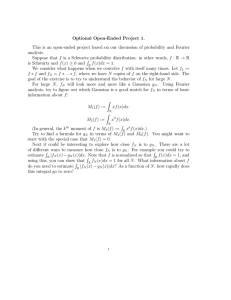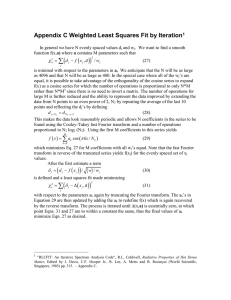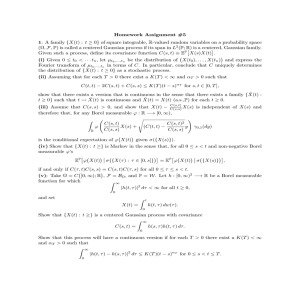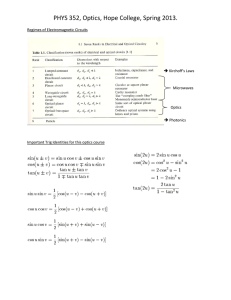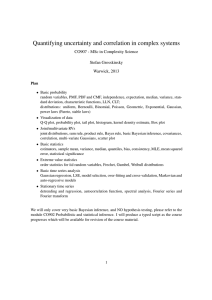Generating stationary Gaussian random fields 1 Fourier Transforms Miranda Holmes
advertisement
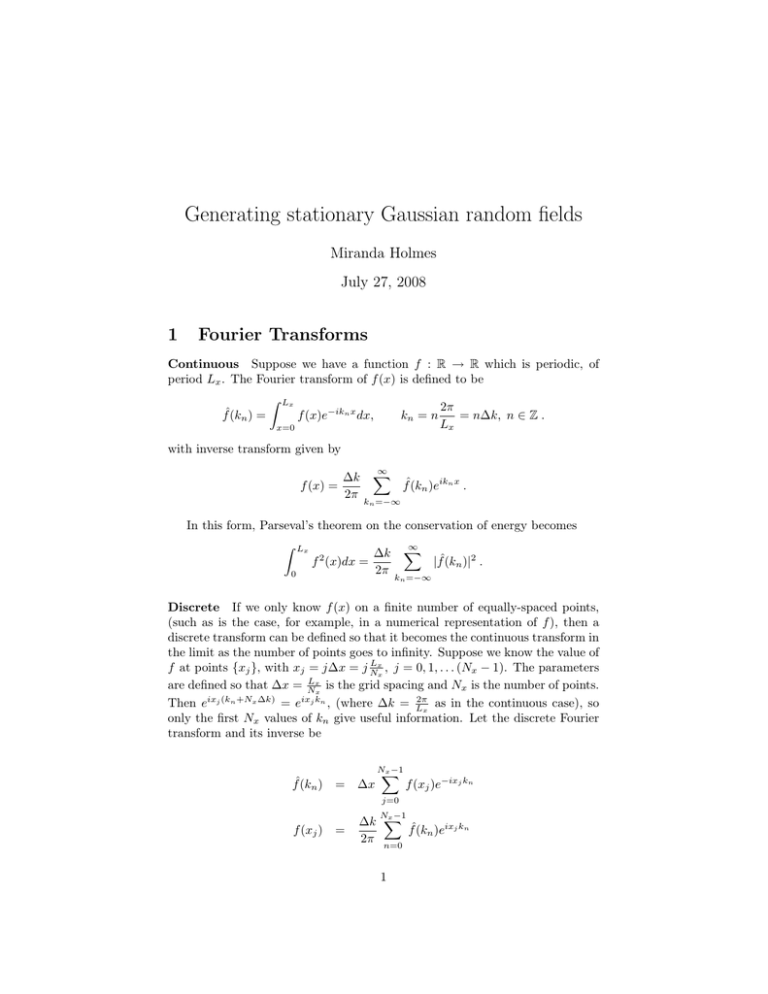
Generating stationary Gaussian random fields
Miranda Holmes
July 27, 2008
1
Fourier Transforms
Continuous Suppose we have a function f : R → R which is periodic, of
period Lx . The Fourier transform of f (x) is defined to be
fˆ(kn ) =
Z
Lx
f (x)e−ikn x dx,
kn = n
x=0
2π
= n∆k, n ∈ Z .
Lx
with inverse transform given by
f (x) =
∆k
2π
∞
X
fˆ(kn )eikn x .
kn =−∞
In this form, Parseval’s theorem on the conservation of energy becomes
Lx
Z
f 2 (x)dx =
0
∆k
2π
∞
X
|fˆ(kn )|2 .
kn =−∞
Discrete If we only know f (x) on a finite number of equally-spaced points,
(such as is the case, for example, in a numerical representation of f ), then a
discrete transform can be defined so that it becomes the continuous transform in
the limit as the number of points goes to infinity. Suppose we know the value of
Lx
f at points {xj }, with xj = j∆x = j N
, j = 0, 1, . . . (Nx − 1). The parameters
x
Lx
are defined so that ∆x = Nx is the grid spacing and Nx is the number of points.
Then eixj (kn +Nx ∆k) = eixj kn , (where ∆k = L2πx as in the continuous case), so
only the first Nx values of kn give useful information. Let the discrete Fourier
transform and its inverse be
fˆ(kn )
=
∆x
NX
x −1
f (xj )e−ixj kn
j=0
f (xj )
=
∆k
2π
NX
x −1
n=0
1
fˆ(kn )eixj kn
Parseval’s theorem becomes
Nx −1
NX
x −1
∆k X
|fˆ(kn )|2 = ∆x
f 2 (xj ) .
2π n=0
j=0
Implementation in Matlab Matlab defines its transforms to be
fˆ(kn )
=
NX
x −1
f (xj )e−ixj kn
j=0
f (xj )
=
Nx −1
1 X
fˆ(kn )eixj kn
Nx n=0
So the above transform can be implemented in Matlab as
F T (f )
=
(fˆ)
=
FT
−1
∆x × MatlabFT(f )
1
× MatlabFT−1 (fˆ)
∆x
2 Dimensions The above transforms can be easily extended to 2 (or more)
dimensions. In 2 dimensions, the transforms are
X
fˆ(k, m) = ∆x∆z
f (x, z)e−i(kx+mz)
x,z
f (x, z)
=
∆k∆m X ˆ
f (k, m)ei(kx+mz)
(2π)2
k,m
with energies
X
∆k∆m X ˆ
|f (k, m)|2 = ∆x∆z
f 2 (x, z) .
2
(2π)
x,z
k,m
2
2.1
Generating Stationary Gaussian Random Fields
Scalar-Valued Fields
Complex-valued fields Suppose we would like to generate a complex-valued
stationary scalar Gaussian random field φ(x) : [0, Lx ] → C with covariance
function C(x), ie E[φ(x0 )φ̄(x0 + x)] = C(x), and expected mean value 0 (a field
with non-zero mean can be constructed by adding the mean on afterwards.)
This can be done most easily in Fourier space, using Ĉ(k) = F T (C). Suppose
we are working with a finite set of points, {xj } and {kn }, defined as before.
(The x-continuous version follows by taking the limit as Nx → ∞.) Let
2
s
φ̂(k) =
Lx Ĉ(k)
(Ak + iBk ) ,
2
where Ak , Bk are independent Gaussian random variables with mean 0,
variance 1. Then
φ(x) = F T −1 (φ̂)
is a Gaussian random field satisfying the requirements (Yaglom 1962).
Parseval’s identity holds for each realization. Taking expected values gives
X
∆k X
E[|φ̂(kn )|2 ] = ∆x
E[φ2 (xj )] = Lx C(0) ,
2π
x
kn
(1)
j
which shows that C(0) can be interpreted as the expected variance per unit
length.
Real-valued fields A real-valued field can be generated from a complex one
by taking real or imaginary parts. By definition, if φ = φ1 + iφ2 is a stationary complex Gaussian random field with covariance function C(x), then φ1 , φ2
are independent, real-valued Gaussian random fields with identical covariance
functions C(x)/2 (eg Hida& Hitsuda, 1990). This leads to nice way to generate
samples of a real field on a computer, as one simply has to generate a complexvalued field with covariance function 2C(x) and take its real and imaginary
parts, giving two realizations for the price of one.
Note that if φ is real-valued, then φ̂ will not be a Gaussian field, as its
¯
Fourier transform satisfies φ̂(k) = φ̂(−k). This leads to an asymmetry in the
equations if we try to generate φ̂ on its own, as the 0-mode, negative modes,
and Nx /2-mode (if Nx is even) must be given special treatment:
q
φ̂(k) =
Lx Ĉ(k)Ak
k = 0, Nx /2
s
Lx Ĉ(k)
φ̂(k) =
(Ak + iBk )
0 < k < Nx /2
2
¯
φ̂(k) = φ̂(−k)
k<0
Ak , Bk are independent N (0, 1) random variables as before.
3
